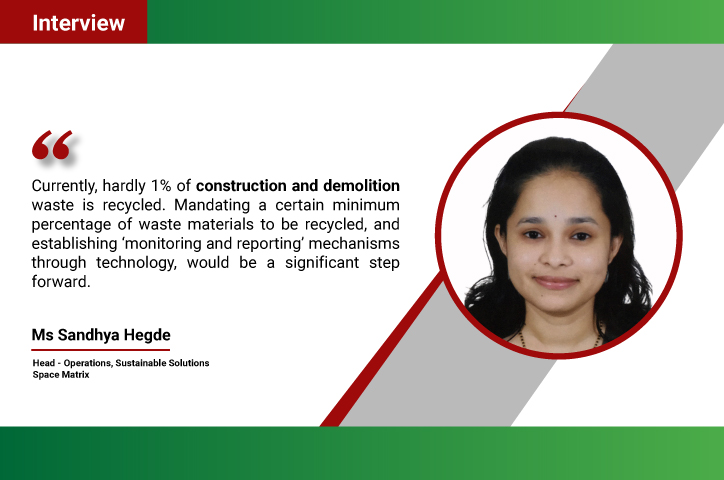In an era where the construction industry faces monumental challenges in waste management, Space Matrix’s groundbreaking initiative, Re:Source, stands as a beacon of hope, ushering in a new era of circular economy principles.
In this interview with TheCSRUniverse, Sandhya Hegde, Head of Operations, Sustainable Solutions, at Space Matrix unveils the genesis of this transformative project, born from collaboration between Space Matrix and Saahas Zero Waste (SZW), a pioneering force in integrated waste management in India. Sandhya delves into the complexities encountered in implementing Re:Source and the innovative solutions that emerged from these challenges which included leveraging technology for efficient waste segregation to forging strong partnerships with stakeholders. She also shares compelling insights into the environmental benefits realized through the pilot project, including significant reductions in CO2 emissions and landfill waste.
With a keen eye on emerging trends and technologies, she anticipates a paradigm shift in the construction industry, driven by circular solutions and low-carbon practices.Drawing from her wealth of experience, Sandhya offers invaluable advice to companies seeking to embrace sustainability.
Scroll down to unravel the story behind Re:Source and explore the transformative power of sustainability in this interview:
Q. Re:Source is a significant step towards integrating circular economy principles in construction waste management. Could you elaborate on what sparked the initiation of this project?
A. Despite accounting for 35% to 40% of global construction wastage, barely 1% of the waste generated by the Indian construction industry gets recycled. This has a significant adverse impact on the environment. As a company committed to sustainable development, we were constantly looking at ways to transform this scenario and make C&D waste management more environment-friendly. We had discussions with Sahaas (SZW), an ISO-certified social enterprise that offers integrated waste management services across major Indian cities. They have been doing stellar work in the field for more than a decade now, and we collaborated to develop the Re:Source framework to channel waste materials back to construction sites. Considering that construction materials make up more than half of a project’s budget, the use of recycled materials can not only curb environmental impact but also help reduce material consumption. Aligned with our planet-positive approach, this was the first pilot project we did under Re:Source. We are looking to continue our collaboration with Saahas Zero Waste (SZW) and implement such initiatives throughout our projects in the future to #makeworldabetterplacetowork.
Q. Managing construction and demolition waste is a complex challenge in India. What are some of the biggest obstacles you faced when implementing the Re:Source initiative, and how did you overcome them?
A. The challenges faced in managing such waste include the difficulty of segregation, often due to limited space at the project site for establishing segregation facilities. Space Matrix and SZW overcame this challenge by leveraging our combined expertise and implementing a two-layered approach. At the initial stage, waste is segregated at the construction site itself. We provide training on waste management techniques to the teams, ensuring primary segregation into different waste categories. Different types of waste such as gypsum, and wood, etc are directly sent to the relevant recycling/co-processing sites. As per the guidelines set under the Re:Source framework, certain types of waste are mixed and sent to the SZW Material Recovery Facility for further sorting. Concrete waste/debris which is not a part of the unsorted dry waste is managed separately whereas the dry waste such as paper, plastic, cartons etc is bailed and sent for recycling/co-processing. The rejected waste is efficiently sent to predetermined landfills for disposal.
Q. What technologies or innovative methods are you employing through Re:Source to ensure the effective recycling and reuse of construction materials?
A. Re:Source adopts a systematic approach to C&D waste management. The waste generated at any project undergoes primary segregation by the construction workers. The segregated wastes get transported to the end destinations from the site itself. The unsorted waste is sent to the Material Recovery Facility (MRF) for secondary sorting. The segregated C&D waste such as Gypsum, concrete, debris, wood, etc., goes to the end destinations such as manufacturing plants, recycling facilities, co-processing facilities, etc. The dry waste bales of plastic, paper waste, etc are also sent for recycling. The rejected waste is transported to landfills for disposal. We have been exploring the right-end destinations that could use the C&D waste for recycling with very little processing.
Q. How does your partnership with Saahas Zero Waste enhance the capabilities of Project Re:Source? Could you share how the synergy between your organisations contributes to the project's success?
A. Our collaboration with SZW has led to proactive steps that bring about the desired change. They have an excellent track record of collaborating with corporates, housing societies, government agencies, and other stakeholders in the arena of circular economy, and zero-waste initiatives. With the environmental challenge posed by India’s C&D waste, this partnership has the potential to integrate the circular economy principles in all construction projects. Together, we can make a significant impact and contribute to our vision of sustainability to #makeworldabetterplacetowork while combating climate change. The pilot project has been hugely successful, and this synergetic association is going to continue making the right impact through Re:Source. Further, we share a common goal of planet-positive business, which makes our partnership very strong and aligned. As a leading design and build firm in the industry, the volume of C&D waste generated at our project sites is significantly high on an annual basis. This will be carefully managed under the Re:Source programme and contribute to the circularity making it a win-win for both the partners.
Q. You’ve mentioned significant reductions in CO2 emissions and landfill waste from your pilot project. What metrics or processes do you use to measure the environmental impact of your recycling efforts?
A. We achieved a significant reduction in CO2 emissions, and landfill waste was reduced by 48% through Re:Source. Various metrics are monitored, and data is gathered to measure these environmental impacts. The pilot project covered an area of 19,570 square feet, and more than 43 tonnes of waste were generated between August and November 2023. Efficient segregation and management of waste resulted in 20.5 tonnes of materials being recycled, and 0.4 tonnes being sent for co-processing. These processes led to a reduction of 15.5 tonnes of CO2 emissions. To sum it up, we will be measuring the recycling and diversion rate from the landfills, and avoiding GHG emissions among a few things.
Q. How do the Construction and Demolition Waste Management Rules, 2016, influence your strategies for waste management? Are there any specific policies you believe need to be introduced or amended to better support recycling efforts?
A. The existing policy frameworks, such as the Construction and Demolition Waste Management Rules of 2016, provide wide-ranging operational instructions. However, there is not enough emphasis on and monitoring responsible disposal. Currently, hardly 1% of C&D waste is recycled. We believe that mandating a certain minimum percentage of waste materials to be recycled, and establishing ‘monitoring and reporting’ mechanisms through technology, would be a significant step forward. The government can also incentivise companies that adopt circular economy principles in the construction industry. This would lead to a surge in the adoption of such practices.
Q. How do you engage with clients to onboard them with the sustainability goals of Re:Source? What role do they play in the success of these initiatives?
A. Almost every business organisation is now concerned about climate change and the environmental impact of their operations, including construction activities. We held detailed discussions with our clients for Re:Source, and they would instantly embrace the proposal by clearly understanding the impacts that Re:Source can have on the environment. The role of clients is critical to the success of such initiatives, as they must provide space for setting up on-site waste segregation, and they also share the financial input required for such projects. However, our clients have been very forthcoming in understanding the long-term benefits and the need for such initiatives, and we anticipate greater implementation of Re:Source in the years ahead.
Q. Following the outcomes of the pilot project, what are your plans for scaling Re:Source? How do you envision expanding these efforts across India?
A. We are now looking forward to scale and deploy project Re:Source in our future projects across India. We have been holding deliberations with our clients, and the partnership with SZW on this project has been a great success. Thus, there is no doubt that we will witness a pan-India expansion of such efforts.
Q. What are the key trends you observe regarding sustainable practices in the construction industry in India? What changes do you hope to see in the industry in 3-5 years?
A. Currently, more construction projects are adopting Green Building Principles and even going for certifications such as LEED, IGBC, GRIHA, etc. These certifications result in both tangible and intangible benefits i.e., reduced energy and water bills and operational costs, better indoor environmental quality, and increased reputation of the project. Circular Solutions will be one of the biggest drivers of change in the Construction industry in the coming years considering the limited availability of resources, unforeseen geopolitical risks associated with the supply chain, and cost-effectiveness apart from the environmental and social impacts that can offer to the Construction Industry. Additionally, the Low Carbon Products and Solutions will be of utmost priority for projects to meet the company’s Net Zero Goals.
Q. What advice would you give to other companies looking to integrate sustainable practices into their construction processes? What key insights have you gained from leading Space Matrix’s sustainability initiatives?
A. Our advice to other companies would be that practicing sustainability is important not only to gain competitive advantages, but also because of the benefits it offers to all the key stakeholders. Key insights that we gained from leading the sustainability initiatives are as follows:
- Make ‘sustainable practices’ a part of the default processes to have wider reach
- Define the goals very clearly, have measurable impacts, and build a connection with the impacts
- Engage stakeholders very often, discuss the challenges, and be transparent about the outcomes
- Talk about the achievements of the initiatives to inspire others for better participation















.jpg)




